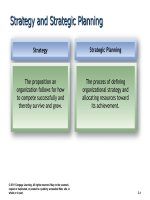Ch08 international human resource management cengage
Bạn đang xem bản rút gọn của tài liệu. Xem và tải ngay bản đầy đủ của tài liệu tại đây (799 KB, 24 trang )
Nature of Training
• Training
A process whereby people acquire capabilities to aid
in the achievement of organizational goals.
Includes
both hard and soft skills
Poorly trained employees may perform poorly and
make costly mistakes.
© 2011 Cengage Learning. All rights reserved. May not be scanned,
copied or duplicated, or posted to a publicly accessible Web site, in
whole or in part.
8–1
FIGURE 8–1
Types of Training
© 2011 Cengage Learning. All rights reserved. May not be scanned,
copied or duplicated, or posted to a publicly accessible Web site, in
whole or in part.
8–2
Organizational Strategy and Training
• Benefits of Strategic Training
HR and trainers partner with operating managers
to solve problems, and to make contributions to
organizational results.
Managers are less likely to think that training alone
can solve performance problems.
• Training’s Effects on Competitiveness
Training makes organizations more competitive.
Training helps retain valuable employees.
Training helps accomplish organizational strategies.
© 2011 Cengage Learning. All rights reserved. May not be scanned,
copied or duplicated, or posted to a publicly accessible Web site, in
whole or in part.
8–3
Organizational Competitiveness
and Training
• Knowledge Management
Is identifying and leveraging intellectual capital to
create value and be competitive.
Gets the right knowledge to the right people at the
right time so that it can be shared and put into action.
• Training as a Revenue Source
Marketing training with or alongside products can
contribute significantly to a firm’s revenues.
© 2011 Cengage Learning. All rights reserved. May not be scanned,
copied or duplicated, or posted to a publicly accessible Web site, in
whole or in part.
8–4
Developing Strategic Training Plans
• Effective training efforts consider the following
questions:
Is there really a need for the training?
Who needs to be trained?
Who will do the training?
What form will the training take?
How will knowledge be transferred to the job?
How will the training be evaluated?
© 2011 Cengage Learning. All rights reserved. May not be scanned,
copied or duplicated, or posted to a publicly accessible Web site, in
whole or in part.
8–5
Orientation: Planning for New Employees
Establishes favorable employee
impression of the organization
Provides organization
and job information.
Bring more work-related
experiences into the process
Achievements
of Effective
Orientation
Accelerates socialization and
integration of new employees
Ensures employee performance
and productivity begins quickly
© 2011 Cengage Learning. All rights reserved. May not be scanned,
copied or duplicated, or posted to a publicly accessible Web site, in
whole or in part.
8–6
Effective New Employee Orientation
Prepare for new
Sample
employees
Consider using
Sample
mentors
Evaluate and
follow up
Avoid information
Sample
overload
Making Employee
Sample
Orientation
More Effective
Present orientation
Sample
information
effectively
© 2011 Cengage Learning. All rights reserved. May not be scanned,
copied or duplicated, or posted to a publicly accessible Web site, in
whole or in part.
Use an orientation
Sample
checklist
Cover needed
Sample
information
8–7
Establishing Training Objectives
and Priorities
• Gap Analysis
The distance between where an organization is with
its employee capabilities and where it needs to be.
Types of Training Objectives
Attitude
Knowledge
© 2011 Cengage Learning. All rights reserved. May not be scanned,
copied or duplicated, or posted to a publicly accessible Web site, in
whole or in part.
Skill
8–8
FIGURE 8–6
Training Design Elements
© 2011 Cengage Learning. All rights reserved. May not be scanned,
copied or duplicated, or posted to a publicly accessible Web site, in
whole or in part.
8–9
Principles of Adult Learning
Have need to know why they
are learning something
Have need to be self-directed
Bring more work-related
experiences into the process
Adult Learning
Employ a problem-solving
approach to learning
Are motivated by both extrinsic
and intrinsic factors
© 2011 Cengage Learning. All rights reserved. May not be scanned,
copied or duplicated, or posted to a publicly accessible Web site, in
whole or in part.
8–10
From Training to the Job
• Transfer of Training
Occurs when trainees actually use on the job what
they learned and maintain use of the learned material
over time.
• Increasing the Transfer of training
Offering trainees an overview of training content and
process.
Ensuring that the training mirrors the job context.
© 2011 Cengage Learning. All rights reserved. May not be scanned,
copied or duplicated, or posted to a publicly accessible Web site, in
whole or in part.
8–11
Training Delivery: Considerations
• Nature of training
• Subject matter
• Number of trainees
• Individual versus team
• Self-paced versus guided
• Training resources/costs
• E-learning versus traditional learning
• Geographic locations
• Time allotted
• Completion timeline
© 2011 Cengage Learning. All rights reserved. May not be scanned,
copied or duplicated, or posted to a publicly accessible Web site, in
whole or in part.
8–12
FIGURE 8–7
Training Delivery Options
© 2011 Cengage Learning. All rights reserved. May not be scanned,
copied or duplicated, or posted to a publicly accessible Web site, in
whole or in part.
8–13
Internal Training
• Informal Training
Training that occurs through interactions and
feedback among employees.
• On-the-Job Training (OJT)
Based on a guided form of training known as job
instruction training (JIT)
Problems with OJT:
Poorly-qualified
Disruption
Bad
or indifferent trainers
of regular work
or incorrect habits passed on
© 2011 Cengage Learning. All rights reserved. May not be scanned,
copied or duplicated, or posted to a publicly accessible Web site, in
whole or in part.
8–14
FIGURE 8–8
Stages for On-the-Job Training
© 2011 Cengage Learning. All rights reserved. May not be scanned,
copied or duplicated, or posted to a publicly accessible Web site, in
whole or in part.
8–15
Internal Training
• Cross-Training
Is training people to do more than one job.
Increases flexibility and development
• Challenges of Cross-Training
Is not favored by employees
Threatens unions with loss of job jurisdiction and
broadening of jobs
Requires different scheduling during training
Causes loss of productivity as people learn
© 2011 Cengage Learning. All rights reserved. May not be scanned,
copied or duplicated, or posted to a publicly accessible Web site, in
whole or in part.
8–16
External Training
• Reasons for External Training
Less expensive to outsource training
Insufficient time to develop training
Lack of expertise
Advantages of interacting with outsiders
• Outsourcing of Training
Cost and greater emphasis on internal linking of
training to organizational strategies, and other issues.
Increasing popularity of vendor training/certification
Government-supported job training
Educational assistance programs
© 2011 Cengage Learning. All rights reserved. May not be scanned,
copied or duplicated, or posted to a publicly accessible Web site, in
whole or in part.
8–17
Combination Training Approaches
Forms of Cooperative Training
School-to-Work
Transition
Apprentice
Training
© 2011 Cengage Learning. All rights reserved. May not be scanned,
copied or duplicated, or posted to a publicly accessible Web site, in
whole or in part.
Internship
8–18
FIGURE 8–9
Most Common Apprenticeship Occupations
© 2011 Cengage Learning. All rights reserved. May not be scanned,
copied or duplicated, or posted to a publicly accessible Web site, in
whole or in part.
8–19
E-Learning: On-Line Training
• E-Learning
The use of the Internet or an organizational intranet to
conduct training on-line.
E-Learning Methods
Distance Training/
Learning
Simulations
and Training
© 2011 Cengage Learning. All rights reserved. May not be scanned,
copied or duplicated, or posted to a publicly accessible Web site, in
whole or in part.
Blended
Learning
8–20
FIGURE 8–10
Advantages and Disadvantages of E-Learning
© 2011 Cengage Learning. All rights reserved. May not be scanned,
copied or duplicated, or posted to a publicly accessible Web site, in
whole or in part.
8–21
FIGURE 8–11
Levels of Training Evaluation
Ease of Measurement
© 2011 Cengage Learning. All rights reserved. May not be scanned,
copied or duplicated, or posted to a publicly accessible Web site, in
whole or in part.
8–22
Training Evaluation Metrics
• Cost-Benefit Analysis
A comparison of costs and benefits associated with
organizational training efforts
Measurement
of both the costs and the benefits
may be difficult.
• Return on Investment (ROI) Analysis
• Benchmarking
© 2011 Cengage Learning. All rights reserved. May not be scanned,
copied or duplicated, or posted to a publicly accessible Web site, in
whole or in part.
8–23
Calculating Training Costs and Benefits
1. Determine overall
training costs
Cost-Benefit
Analysis
2. Identify potential
savings results
3. Compute potential
savings
4. Conduct costs and savings
benefits comparison
© 2011 Cengage Learning. All rights reserved. May not be scanned,
copied or duplicated, or posted to a publicly accessible Web site, in
whole or in part.
8–24









